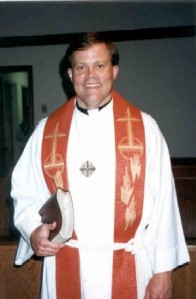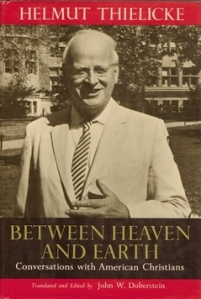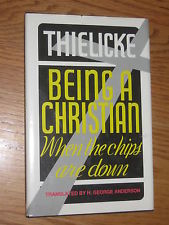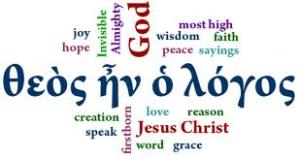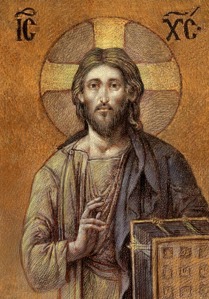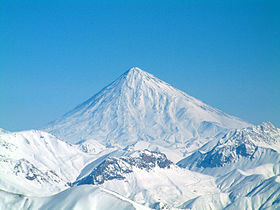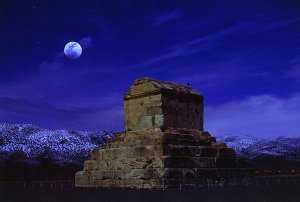Posts Tagged ‘Dr. C. George Fry on Helmut Thielicke’
An Overview of Jonah as Prototypical Primer for Catacomb Church and Homeschool Study

Jonah in distress in the 8th century B. C. He was a prototype of coming distress for the Northern Kingdom of Israel and Samaria. Is there a contemporary historical analogy and application?
I am most honored to be with you today as an invited guest on this Sunday afternoon. Let me say at the outset that it has been a long time since I’ve been in front of a group of evangelicals in a home or classroom setting to provide an overview of a Biblical book or a topic of history or systematic theology. Years ago when a most improbable set of circumstances brought me to the now defunct Texas Bible College in the Alamo City to teach Biblical courses, apologetics, church history, and communications for several years, I had the pedagogical experience of my life in front of a group of young people who saw learning the material as an exciting journey and odyssey of a lifetime.
What I remember most is what Lutheran pastor and theologian Helmut Thielicke once referred to as “intense listening.” I covered the context of Pastor Thielicke’s phrase in a presentation I delivered to a Lutheran gathering in the Middle West 4 years ago. In a nutshell, Dr. C. George Fry chronicles that context in his article on Thielicke in the Handbook of Evangelical Theologians (Baker, 1993) on pages 219-233. Dr. Fry explains how and why this great man was in academic and professional exile in the early days of World War II, how he came out of exile under circumstances that can only be explained as the work of God in history, and how through his teaching skills and personal acquaintance with the Gospel, the Stuttgart Cathedral lectures to the beleaguered German people transpired even as Allied air raids drew ever nearer to them. Fry noted that:

Helmut Thielicke: Preaching the Gospel near Midnight in the Stuttgart Cathedral during the apocalyptic Allied Air Raids. He experienced “intense listening” never seen again.
“As he lectured [in Stuttgart Cathedral] on its five principle parts [Small Catechism of Luther]–the Ten Commandments, the Apostles’ Creed, the Lord’s Prayer, Baptism, and the Lord’s Supper–‘evening after evening some three thousand persons gathered together; workers and businessmen, students and professors, soldiers and generals, Nazi functionaries (naturally in civilian clothes!) and Jews, Dutch compulsory laborers . . . and sometimes whole classes from the schools. It was an overwhelming time for me. Never since have I experienced such intense listening.’ Soon the massive air raids began. When the streetcars could no longer run, people ‘came on foot, often from many miles away, through the fields of ruins and rubble’ even on dark and frightening winter evenings. But then the [Stuttgart] cathedral was destroyed. Thielicke wrote, ‘I can still see the towering torch of this venerable house of God. . . . I stood there holding in my hand a key to a door that no longer existed.’”
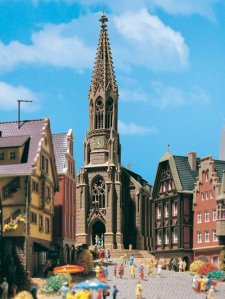
The original Stuttgart Cathedral is located in Stuttgart-Bad-Canstatt. Its history goes back all the way to 1470. After massive destruction during the Second World War, the church was rebuilt in 1954/55.
The lesson is this: When there is great opportunity for evangelical believers to gather together around a meaningful study of the Word of God, that is an opportunity to be seized at the moment in time it is offered. Just as the Stuttgart Cathedral was torched in a single evening of air raids, so it was that Texas Bible College closed under less dramatic circumstances after a handful of semesters of teaching for me there. Thielicke noted later in his life that those times of “intense listening” would never come again. I never experienced it again either, although I sense in our group this afternoon that the Lord has many mutual blessings for us in the handful of occasions when I will be your guest in this house to share my thoughts and materials with you. And please keep in mind that just as there was a sense of great apocalyptic and eschatological expectation among the German people who flocked to the Thielicke lectures in Stuttgart Cathedral, there is a strong scent of apocalyptic and eschatological expectation in history among those of us in the Remnant Church most desirous of spending more time in the Word of God and in fervent intercessory prayer. I addressed this very thing in the last public theological presentation made to anyone in 2017 in “The Church of Smyrna Speaks to the Confessing Church of Christ in this Darkening Hour.” Later in the year, I would be given 5 minutes to speak at a Lutheran convention in a foreign country with reference to this article. In addition to the shortness of time allotted, the convention folks were preoccupied with choosing a new president and adopting a new organizational structure. John on Patmos and the application of the Apocalypse to the present historical situation of the Remnant Church in the Western World and elsewhere wasn’t apparently on their agenda for the week. I know it is on yours or I would not have been asked to come here. The point is this: You know the hour. You want your loved ones to have the best grasp of Scripture possible as persecutions and circumstances worsen. And I’d rather be with 7 folks here in this house on a Sunday afternoon than all the denominational meetings and conventions extant. Put slightly differently, I tend to hate those gatherings. Enough said.
My second introductory point pertains to the political realm in the world, our need to be presently informed and watchful observers of the events within it in this country and abroad, and to take note of Paul’s warnings in Ephesians 6 about the demonic realm’s influence and operations within world governments. Why? Because: 1) The Lord Jesus Christ Himself, and both the Old Testament Prophets and the New Testament Apostolic Writers underscore the importance of discernment in battling demonic deception in world history at every point on the linear time line which runs from the Fall to the Second Advent of the Lord. 2) No Biblical writing can be properly studied and even partially understood without constant reference to the historical context and events that enshrouded the particular author, including Jonah. And what Biblical principles at these various stages of redemptive history properly inform the Remnant Church now as to what God is accomplishing at present through individuals, collective entities, world leaders and empires, and technological advancements making global surveillance systems, economic manipulations, media misinformation, and military weapons of mass destruction and mass murder ever greater threats to the survivability of the planet? Does not the age of the Tower of Babel in Genesis, Nebuchadnezzar of Babylon in Daniel, and Nero and Domitian of the Ancient Roman Empire as chronicled by the Apostle John on Patmos in Revelation, provide us with prototypical clues regarding the New World Order and the impending unveiling of Antichrist? And to reiterate, 3) the Lord in the Olivet Discourse (Matthew 24/Mark 13/Luke 21) mentions the concept of deception more than that of any other idea in his chronicling of the run-up to the end of history and His return. The principle and the lesson is this: Assiduous study of the Word of God, acquiring proper tools in doing so, developing solid principles for applying the Old and New Testament to legitimate contemporary applications, including discerning the larger meaning of present and future events in history, are within your grasp and mine as we work within our mutual limitations as best we can, and ask the Holy Spirit of God to reveal what He desires that we truly hear, see, and take to heart in the times in which we live. Only these things can and will enable us to penetrate falsehoods and deceptions in these end times and to recognize false prophets and wolves when they insiduously infiltrate and attack. Rest assured that they are, and that they shall. And as we shall see shortly, interpretation and understanding of the context of the story of Jonah is inextricably linked with the political developments of his time as they pertained both to the Northern Kingdom of Israel and the nation of Assyria.
In closing this second point of introduction, let me note what many of you already know from things you have read or heard about me. I have been intensely involved in the political realm for many years, for reasons directly related to what I believe about eschatology, and what I believe are the particular forces Satan has been working through in both the United States specifically and the West generally to destroy Christian societies, civilizations, and churches, especially since the earliest portion of the 20th Century onward. My last post in this arena was this past January. I do not know if there will be any more, or any additional TV or radio commentary. My mission in all of this may already be past. It is my hope that people in the future who come across my work since 2001 will understand the context of why I embarked upon this journey in the critical years in question, and what I was trying to accomplish as one of a relative handful of voices exiled in the desert in wintertime. Time tells.
Beginning today, I hope to equip you with a basic structural methodology for studying any Biblical book. The book you have selected as a test case example is Jonah.
Before beginning our quest to examine the Book of Jonah more closely, let me say several things about tools for studying Scripture and consulting the best sources available to you or me. The first is the Annotated Bibliography. I emphasize Annotated because this term underscores that one is not simply provided with a list of books on a particular subject or discipline, but helpful comments and guidance on the strength and weaknesses of a particular book, the ideological background of the author(s), and the particular tradition or school of thought out of which said author(s) comes. As but one example, is the author an evangelical/orthodox scholar theologically, as we understand that term shall be used in this class, or does he/she come from the realm of Higher Criticism and Historical Criticism which provide a brand of scholarship with far different presuppositions and conclusions than any of us would accept as viable? Among evangelicals, what is a Dispensational Premillennialist? An Amillennialist? What is the context of the Calvinistic-Arminian controversy over free will and election? What is the difference between a Lutheran and a Zwinglian in interpretation of major Biblical passages pertaining to the Lord’s Supper? What are the different schools of interpretation that have existed in history to explain the Prophecy of 70 Weeks in Daniel, chapter 9?
These are just a few of the important ideas to have an acquaintance with in any evaluation of what we read in any commentary on these subjects at hand. Hint: All of us come to the Biblical narrative with a background and historical framework, whether we are conscious of this or not, or frank enough to acknowledge the obvious. Just in brief Internet search I found an interesting list with comments here. Check out another possibility for Jonah research here. The evangelical Denver Seminary has a list of Old Testament commentary recommendations here. And the famous evangelical Westminster Theological Seminary in Philadelphia, an offshoot of Princeton historically, has a variety of tools available to any of us. I introduce two suggestions at this point with Annotated Bibliographies: 1) Those prepared by known evangelical schools and sources are likely to be best for our use. 2) Having said that, please do not cheat yourself of the insights and contributions to be made in understanding a subject often contributed by scholars we do not agree with in key areas. Example: The great Lutheran scholar and historian, Jaroslav Pelikan (later Eastern Orthodox), had a view of the Scriptures heavily influenced by historical criticism and at odds with that of more orthodox, evangelical Lutherans. Having said that, if one engages in the study of historical theology, it is impossible not to avail oneself of his brilliant mind and research as exhibited in his 5 volume set on Church History, entitled The Christian Tradition: The History of the Development of Doctrine. I have this set, and am presently reading Volume 2 on my own, to learn more about Eastern Orthodoxy. Do you know what I was exposed to on this subject in an evangelical seminary? Absolutely nothing is the correct answer. The lesson is this: Protestant evangelicals are heavyweights in exegesis of the Word of God. They tend to be extremely weak as historians in the area of the development of doctrine. Take the predominant eschatological position of evangelicals on the final events of world history, especially as they pertain to the modern State of Israel vis a vis the Israel of God. How many know the beginning of the rudimentary elements of this position first emerge in the writings of a Jesuit priest in the 16th century, subsequently to be systematized by John Nelson Darby and popularized by the Scofield Reference Bible in the 19th century? One evangelical source for examining this subject and providing a fair treatment to both sides of this debate may be accessed here. The Annotated Bibliography for this single key subject alone is enough to fill a few libraries in and of itself. Enough said.
Where tools are concerned, the multi-volume Zondervan Charts are critically valuable. I have been collecting them for years.
And finally, if one desires to learn enough Greek and Hebrew through a reputable online course, the best tools for subsequent word studies and research include the Theological Wordbook of the Old Testament (Harris, Archer, Waltke), the updated version of the New International Dictionary of New Testament Theology and Exegesis (Moises Silva, ed.), and the Theological Dictionary of the New Testament (10 vols, Kittel/Friedrich). The classic Brown-Driver-Briggs Hebrew and English Lexicon, the accompanying Index to the Brown-Driver-Briggs Hebrew and English Lexicon, the infamous Strong’s Exhaustive Concordance, A Greek-English Lexicon of the New Testament and Other Early Christian Literature (Bauer-Arndt-Gingrich or “BAG”) and An Index to the Revised Bauer-Arndt-Gingrich Greek Lexicon (John R. Alsop, Zondervan) round out some of the basics for those who want to dabble in these scholarly arenas. We do not have to be world-famous scholars to use these. Over time, I can easily show you how. By the way, the Bauer-Arndt-Gingrich (“BAG”) edition is a first edition. Later, there was a second edition in 1979 that involved my late Lutheran colleague William Danker, hence the later acronym BAGD. And to make matters even more ridiculous for you, when a 3rd edition of A Greek-English Lexicon of the New Testament and Other Early Christian Literature was subsequently issued in 2000, the acronym for the 4 scholars was rearranged for reasons beyond me. This 3rd edition is referred to by insiders as BDAG (Bauer-Danker-Arndt-Gingrich). Go figure. As for me, I still have the 2nd edition known as BAGD. This is for reasons of nostalgia that go back almost 37 years. The legendary Dr. Douglas Moo (follow your Annotated Bibliographies for the New Testament) was the one who beat me to death in summer Greek Exegesis courses in 1981 after I barely passed the crash course of 2 years of college Greek in 2 previous semesters at Trinity Evangelical Divinity School to qualify for Moo. He found it humorous when I slipped him a note to suggest early termination of a class that academically overwhelming summer of 1981 to get to a Cubs game in Wrigley Field that particular afternoon. The note read: “Dr. Moo. May we BAG this for the Cubs’ game today? Dankof. (BAGD from that time on wasn’t for Bauer-Arndt-Gingrich-Danker but for BAG [this]D[Signed, Dankof].” His response: “Funny, but I have BAGGED your suggestion. Dr. M.“
If you would like to explore the possibilities for yourself or your kids in learning enough New Testament Greek for the use of some of these tools in word studies, my written transcript of today’s conversation will contain a link here. Again, this may never be your desire, but I always chronicle these things in order that someone will have a resource to consult months, years, or decades later. I still use my notes, my course syllabi, references on note cards to something discovered in a particular resource, flash cards, and updated Annotated Bibliographies as needed, to get to the bottom of something in my personal studies. Two classic examples involve a single piece of paper where my late friend, Pastor John Eppler, tutored me for a week in the Hebrew alphabet and its phonetic sounds, to enable me to pass summer months of constant Hebrew immersion with Dr. Samir Massouh at Trinity Evangelical Divinity School in the summer of 1982. Sadly, we lost Pastor Eppler in late 2004. After John got me through the alphabet and Hebrew immersion with Dr. Massouh, I would enjoy OT 711, or “Poetry and Post-Exilic History” with the latter that fall. Sadly, Samir Massouh now struggles with esophageal cancer and chemotherapy at the St. Francis Hospital in Kenosha, Wisconsin, north of Chicago. How I miss these men.

The late Pastor John Eppler’s handwriting instructs me in the Hebrew alphabet and phonetic pronunciation on a piece of notebook paper in the summer of 1982.
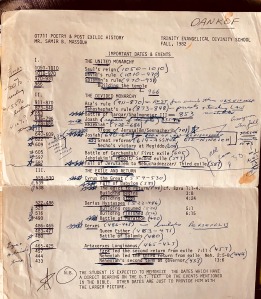
Dates of OT significance to memorize in the Fall of 1982.
One nostalgic story about Samir Massouh is in order. In my last Hebrew course in the summer of 1982, the final exam contained a lengthy translation. I “Aced” that portion of the exam. Several days later, he asked me to come to his office. He seemed troubled. I knew what was bothering him. He noted my never-before-noted-and-sudden brilliance on that portion of the exam. He also ventured that he believed me to be 1) an honorable person and 2) an improving but still mediocre Hebrew student at the graduate level. With those hypotheses ruminating in his mind, he asked if I had an explanation for my sudden foray into Hebrew exegetical skills matching his own, or Gleason Archer’s.

The Crucifix and the Sacramental Altar of Trinity Lutheran Church and School in Wahiawa. Every Wednesday morning, The Venite was sung by the children in the Matins Service (Psalm 95).
My answer was truthful and explanatory: “The answer is the Venite which I sang every Wednesday morning in 3 years of grade school at Trinity Lutheran School in Wahiawa, Hawaii in the 1960s during the Chapel Matins Service. It’s contained in the Matins Service on page 32 in The Lutheran Hymnal. The Venite is Psalm 95 used as a canticle in the Western liturgy, usually for Matins.” (Massouh’s test translation for the last Hebrew exam of the summer of 1981 was Psalm 95. Virtually none of the pan-Protestant evangelical students taking that exam knew anything about historic liturgy, especially in the Evangelical Free Church of America, the Bible Church tradition, the Conservative Baptist denomination, et. al. But the singular Lutheran with a childhood background in Western Liturgical Worship knew it by heart.)
Samir Massouh’s countenance reflected a combination of humor and relief. He said, “So this explains why you were humming while you were writing.” My response: “Exactly. After two lines, I recognized the entire pericope. But I could best bring everything back to total recall by humming the melody of the liturgical setting for Psalm 95 used then for Matins. It went much faster than trying to recite it without the music.“
I asked him if I would still receive my A. He said with a smile and beaming eyes, “Yes. and get out of here.” My response as I was opening the door to leave was “See you for Post Exilic History this fall.”
There is a postscript to this story. In the following spring of 1983, Trinity Journal (TRINJ 04:1/Spring 1983, page 84) came out with an article by Dr. Massouh. It was entitled, “Exegetical Notes Psalm 95,” and began with introductory comments on worship:
“Recent publications have reflected a renewed evangelical interest in the nature and manner of worship. Some have advocated incorporating charismatic enthusiasm while others have promoted the use of more liturgy. It is in the light of such revived interest that this study of Ps 95 is given, in order to establish some biblical principles about the nature and manner of worship.”
I ran into him on campus shortly after the article was released. I observed wryly, “You’re the first Trinity professor who ever plagiarized any of my stuff.” He got the humor.
Lesson: Never forget the most special people God has ever placed, or will place, in your life. Think about the principles of instruction provided. I will say it again. I will never forget those men, and those times. And if the truth be known, one of the great mistakes in my life was not staying there for a much longer period of trial and hardship to develop the skills and the calling I did not realize were emerging until many years later. I have one thesis to finish and one more language exam to finance and sustain in preparing for whatever remains of my life in the time left. Only God knows how this will be possible or where in this present world it leads, but He assures us he is in the Impossibility business (Luke 1:37).
Now we move on to a brief roadmap of introductory structure and notes for the Book of Jonah, which as indicated earlier is in prototypical form and concept what I do in the study of any Biblical book. (Aside: If you’re counting, my Word Processor informs me that you and I have now covered not quite 3500 words. Again, the electronic version of this conversation will enable you to get to the Links to some of the resources discussed here in the living room of this house.)

When God calls us to go to a destination 550 miles away, His purposes through us will still be accomplished if we run 2500 miles in the other direction. [Book of Jonah]
A Roadmap of Structures and Concepts for Studying a Biblical Book: Test Case is Jonah.
Place of the Book in the Canon and in the Redemptive History Timeline: For your Prototypical Analysis, think Patriarchs and Israelites/United Monarchy/Divided Monarchy/Babylonian Captivity/Intertestamental Period. Jonah: Divided Monarchy. Northern Kingdom of Israel. Minor Prophet.
Title: Named after its principal character. Jonah means “dove.” Compare with Hosea 7:11; Psalm 68:13 and 74:19.
Date: 800-750 B. C. for the prophetic ministry of Jonah. Authorship of the book prior to the destruction of Samaria and the Northern Kingdom of Israel at the hands of the Assyrians in 722 B. C. Hint: Compare evangelical commentaries with those of higher critical/liberal persuasion on this issue. The date of the revival in Nineveh recorded in Chapter 3 is believed to coincide with the reign of Ashurdan III (773-755 B. C.). Interesting speculation: Did two plagues in Assyria (765 and 759 B. C.) and a solar eclipse in 763 B. C. prepare the people for Jonah’s message of repentance or judgment?
Author: The book does not identify its author. Tradition assigns it to the prophet himself. (Consult both evangelical and non-evangelical commentaries and sources for the debates on this which ensue. One recommendation: see Gleason Archer’s section on Jonah in his Introduction to the Old Testament [Moody Press] if you can locate this volume. It is especially valuable for providing responsible academic representation of evangelical arguments for the reliability and accuracy of the Biblical narratives as it rebuts the most enduring objections of Higher Criticism and Historical Criticism. I can provide excerpts of these if needed. Archer discusses authorship issues in his comments on Jonah. Don’t dismiss these arguments as personally irrelevant. You or your kids may well need a handle on some of this to provide rebuttal to the unbelieving cynics some of you will encounter in circles of American “higher education.” Enough said. Hint: The arguments you will encounter revolve around higher Biblical critics who claim that Jonah was authored the 5th and 3rd centuries B. C., as a historical fiction espousing universalistic views to counter the “narrow nationalism” of Ezra and Nehemiah.
Jonah is identified as the son of Amittai (1:1) from Gath Hepher (2 Kings 14:25) in Zebulun (Joshua 19: 10,13). 2 Kings 14:25 references him as a prophet in the reign of Jeroboam II of the Northern Kingdom of Israel. Here, we read that under Jeroboam II, the borders of Israel were expanded according to the word of the Lord God of Israel, which He had spoken through his servant Jonah the son of Amittai, the prophet who was from Gath Hepher (3 miles north of Nazareth in lower Galilee).” Keys: the reign of Jeroboam II, Jonah as prophet of the Northern Kingdom, Jonah as a Galilean. Hints: See John 7:52 for a good case of Pharisaical error.
Historical Background: Know your Kings of Judah (south) and Israel (north) after the end of the United Monarchy! There were 20 Kings of Judah. 8 were good. 12 were bad. As for the Northern Kingdom of Israel, all 19 of their Kings from the end of the United Monarchy to the onset of final destruction of the Kingdom and Samaria in 722 B. C. at the hands of the Assyrians were bad. See here. [There are all kinds of historical gems and discerning contemporary application of these gems of instruction. One could look at the last 5 kings of Judah, beginning with Josiah (good) and 4 terrible successors leading to the Exile. Possible application: Think about the succession of American leaders in recent times, the state of the American Empire, and what many American Protestants have embraced as the doctrine of American Exceptionalism. Is that ideology Biblical? How does it square with the reasons for the rise and fall of Empires Biblically? Is this idea a foundational basis for present day susceptibility to deception? End of point. . . . as for Jonah, zero in on Jeroboam II (782-753 B. C./co-regency/41 years in the electronic source, Archer says 793-753 B. C. in his Introduction). Consult the historical background section of the Commentaries you select out of our list.
The reign of Jeroboam II is pivotal to the context of both Jonah and Amos. What are the key points to underscore in understanding the historical backdrop of these prophets and their respective proclamations?
1. The key nations (3) in the historical backdrop are the Northern Kingdom of Israel, Damascus (center of Aramean power), and Assyria.
2. Circa 797 B. C., Elisha spoke to the King of Israel about future victories over Damascus (2 Kings 13: 14-19).
3. The Assyrian military campaign against Damascus in 797 B. C. enables the King of the Northern Kingdom of Israel, Jehoash (798-782 B. C.), to recover territories previously lost to the King of Damascus (2 Kings 13:25).
4. Jonah prophesies the restoration of the Northern Kingdom under Jeroboam II predicted by Elisha (2 Kings 24:25). Internal troubles in Assyria enable Jeroboam II to complete the restoration of Israel’s northern borders.
5. The Northern Kingdom of Israel subsequently falls into a period of nationalistic arrogance, complacency, and spiritual decadence after the restoration under Jeroboam II. The prophetic implications are covered by Amos and Hosea. Amos prophesies an exile beyond Damascus (Amos 5:27). He will proclaim that God’s patience with the Northern Kingdom is at an end (Amos 7:8; 8:2). Hosea indicates that the tool of God’s judgment will be a politically and militarily revived Assyria (Hosea 9:3; 10:6; 11:5). It is in this context that God sends Jonah to Nineveh, the capital of Assyria, to warn it of the imminency of its own eventual judgment. Hint: To contextualize why Jonah attempted to run from God’s command and flee to Tarshish, run a Search Engine probe for “Assyrian Empire Cruelty.” This will bring up many fascinating articles, including one I just discovered for you at Realm of History. Or try this article from the Biblical Archeology Society (Jan/Feb 1991) which is in PDF format.
Christ in Jonah: Gleason Archer tells us in his Introduction to the Old Testament on page 313 that ” . . . one cannot reject the historicity of Jonah without also rejecting the authority of Christ.” See Matthew 12: 38-41 (and the Luke account). Hint: Isolate the word “sign” for further examination (σημεῖον). Jonah is the only prophet whom Jesus likened to Himself. What are the implications? Compare this account to the aforementioned John 7:52. Think Jonah and Jesus in terms of Typology. Further suggestion: The eschatological warnings about “signs and wonders“ in the New Testament. What are the implications? (For now, simply file this in your notes for future study.)

Matthew 12: The deeper implications of the word “sign” (σημεῖον) may lie within the pages of the revised version of the New International Dictionary of New Testament Theology and Exegesis (Moises Silva, ed.)
Structure of the Book: Let’s keep this simple. Some of your commentaries will be more elaborate, but simplicity of structure is often best retained in the mind during study.
1. Jonah flees. (Chapters 1-2)
2. Jonah reluctantly fulfills. (Chapters 3-4)
Related structural issues: 40 verses tell the story of a single, extended episode. 8 additional verses cover Jonah’s prayer of thanksgiving, giving us a total of 48 verses. Jonah’s employment of structural symmetry and style are often compared to the Book of Ruth. The story is told in two parallel cycles (Chapters 1-2/Chapters 3-4) of comparisons and contrasts. There are 3 Confessions of Jonah (1:9; 2:9; 4:2.) The “Middle Confession” of 2:9 is decisive. It proclaims that “Salvation is of the Lord,” and emphasizes that the word of the Lord is the last and final word on anything.
Key Verses: 2: 8-9, and 4:2. (Last 2 Confessions of Jonah)
Key Chapter: Chapter 3. Revival in Nineveh.
Key Ideas for Discussion and Reflection: Is it possible to succeed in running away from God? Are there limits/no limits as to what God can use to get an individual’s attention? An Empire’s attention? Does failure disqualify someone from serving God? What are the consequences of running away from God? What is the experience of the individual who attempts it? Can nationalistic patriotism impede the relationship between the believer and God’s plan? Does Jonah’s testimony reveal a universal concern for all people on the part of the Biblical God? What are the implications of the fact that Nineveh responded to the preaching of Jonah better than the Northern Kingdom of Israel or the Southern Kingdom of Judah did with any of their prophets? Is there a prototypical parallel here with the various reactions to the preaching of the Kingdom of God by Jesus and His apostles recorded in the New Testament? Hint: Compare the reaction to the message of Jonah by the Ninevites to that of those who claimed to be the Sons of Abraham (John 8: 31-41). Implications? Is there a link to 722 B. C., 586 B. C., and A. D. 70? And possibly to Matthew 24/Mark 13/Luke 24/2 Thessalonians 2/Revelation 13?
We are now at the end of our first session together. It is my hope that this overview serves its purpose, not only as an introduction to the Book of Jonah, which we will examine in greater detail in future sessions by studying the text verse-by-verse and chapter-by-chapter, but as a Prototype for the Catacomb Church and the Homeschooling Community in covering any Biblical book. This process is essential to laying out the roadmap for all of the study, all of the discussions, and all of the developments for further study that will inevitably follow. Sometime in the future, I will develop a Prototype for a Topical Study in Scripture which will be shared with you when completed.

Not a Bad View for an Exile on Patmos: An Aegean Sunset.
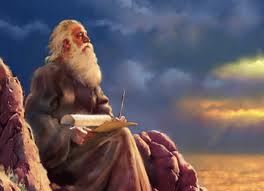
John on Patmos Pens The Apocalypse: Exiled Because of Resistance to the Emperor Worship Cultus of Domitian (A. D. 81-96).

